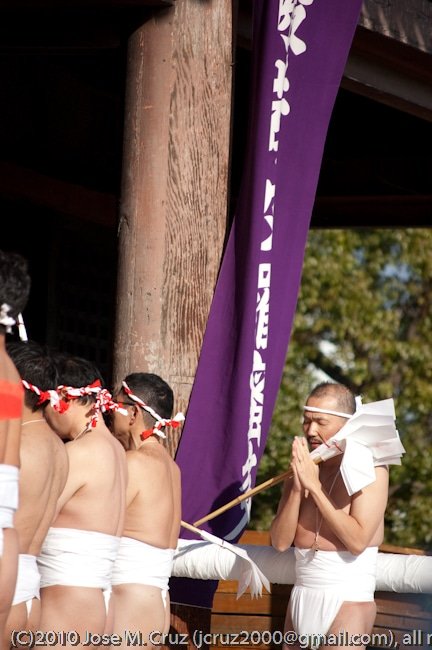
Table of Contents
What is the Doya-Doya Festival?
The Doya-Doya festival is held every year on January 14th at Shitennoji Temple. The celebrations come at the end of the 14 day period of worship after the new year. During this unique and unusual festival, more than 600 young men wearing nothin but a loincloth (fundoshi) and a headband, scramble to gather evil-warding charms/bills. These participants are selected from Seifu High School and Seifu Nankai High School.
The young men are separated into two groups, one wearing red, and one wearing white. The red colour traditionally represents the ‘peasant group’ and the white represents the ’fisherman group’. These two teams race to collect as many of the bills as possible and the team with the most, wins. Whilst the scramble occurs, cold water is splashed on the young men, quickly steaming from their body and clouding the area in white. As they are being soaked they shout the words ‘doya doya’, which comes from the noise that people make when they get into the Rokuji hall or even faces provoking other participants. The collected charms will help them receive good luck for the rest of the year.
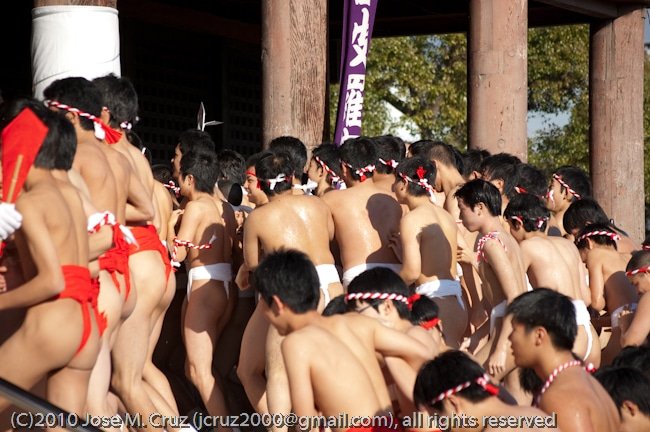
History of the Doya-Doya Festival
In Japan, there are three main festivals called “Japan’s Three Great Naked Festival”:
- “Furukawa Festival” (Gifu Prefecture: April 20th)
- ・“Wakamiya Hachiman Shrine Naked Festival” (Oita Prefecture: held on the weekend near October 15th)
- ・“Saidaiji Aiyo” ( Okayama Prefecture: Held on the 3rd Saturday of February every year)
Although not being one of the major three “great naked festivals”, the Doya-Doya festival is still a key event in Japan.
At Shitennoji Temple, the 14th is the last day of the Japanese Buddhist period of Shushoe. The series of religious events leading up to the 14th, all pray for peace and good harvest. The Doya Doya festival is the same, as it was originally intended for farmers to receive a good harvest for the coming year. Originally, amulets of protection were hung from willow branches on the temple grounds. Neighbouring peasants and farmers would scramble to get a hold of one of the amulets. Worshipers would fight for this amulet as anyone who wear it will not be damaged by pests. From here this tradition was born. The festival has been going since the year 827!
Previously, participants of different generations and backgrounds used to join. However, in order to avoid any accidents or chaos, only students and teachers from the Seifu High School and Seifu Nankai High School are allowed to participate.
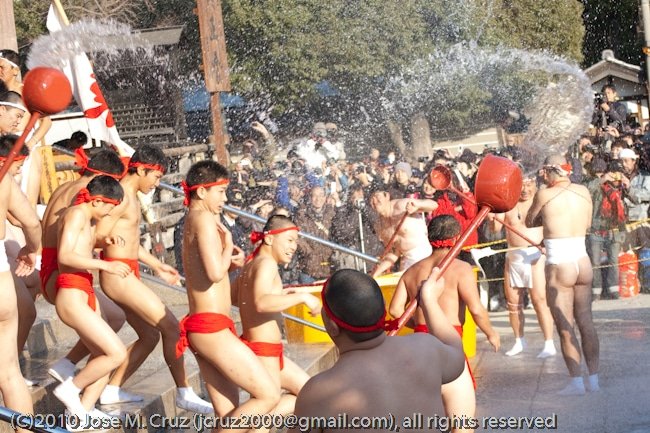
What are Fundoshi?
Fundoshi were the traditional undergarment worn by everyone until World War Two. Woodblock prints show that all types of people, from samurai to fishermen, wore fundoshi. However, they fell out of favour as more convenient and comfy boxers were introduced from the west.
They are traditionally made from white linen or cotton and a usually around five feet long when untied. In recent times, shorter and more colourful fundoshi can be found. At the Doya Doya festival, they wear fundoshi to expose themselves. In older times, it is said that to communicate with god, they should be innocent and without clothes like when we were born.
How to Enjoy the Festival
The festival is separated into 2 parts, the first involving kids and the second involving the high school students. At 14:00, the festival starts with nearby kindergartens and nursery school children performing the Doya Doya. In contrast to the high school students, the first part is much more ordered and supervised by local teachers and organisers. Wearing white clothing and red headbands, the children pray for a good harvest while yelling “Wasshoi Wasshoi!”
After the kids have left, the high school volunteers enter the temple grounds. In front of the main shrine, they split into their two teams (red and white). Firstly, they enter the shrine and pray for a healthy and good year. Upon leaving the shrine, they are doused with water to “purify” them. They then re-enter the shrine and attempt to catch the good luck bills that are dropped from the top of the shrine. Once all the bills have been collected, they proceed around the temple grounds carrying different flags with various meanings such as: ‘Academic Achievement’, ’Distastes Relief Blessing’, or ‘Five grain abundance’.
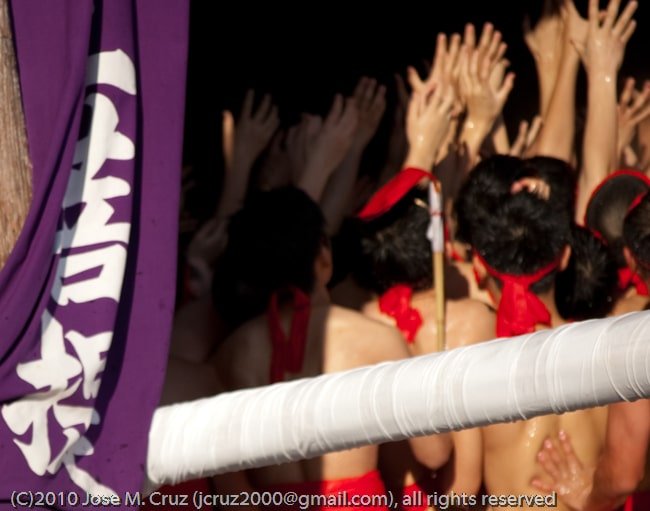
Shinnetoji Temple
Located in the Tennoji district, the Shitennoji Temple is claimed to be the oldest temple in Japan. It was founded in 593 by Prince Shotoku – however nothing remains of the original building as it has continuously been destroyed by fires and rebuilt. The vast temple grounds and beautiful gardens are a must visit, even on a regular day! Furthermore, you can read a little more about the Shinnetoji Temple in our previous article.
Address : 1-11-18 Shitennoji, Tennoji-ku, Osaka, 543-0051
Opening Hours: 8:30 to 16:30 (until 16:00 from October through March)
Tel: 06 06771 0066
Access : 10-15 minutes walk from Tennoji Station on the Midosuji Line
Website : https://www.shitennoji.or.jp/
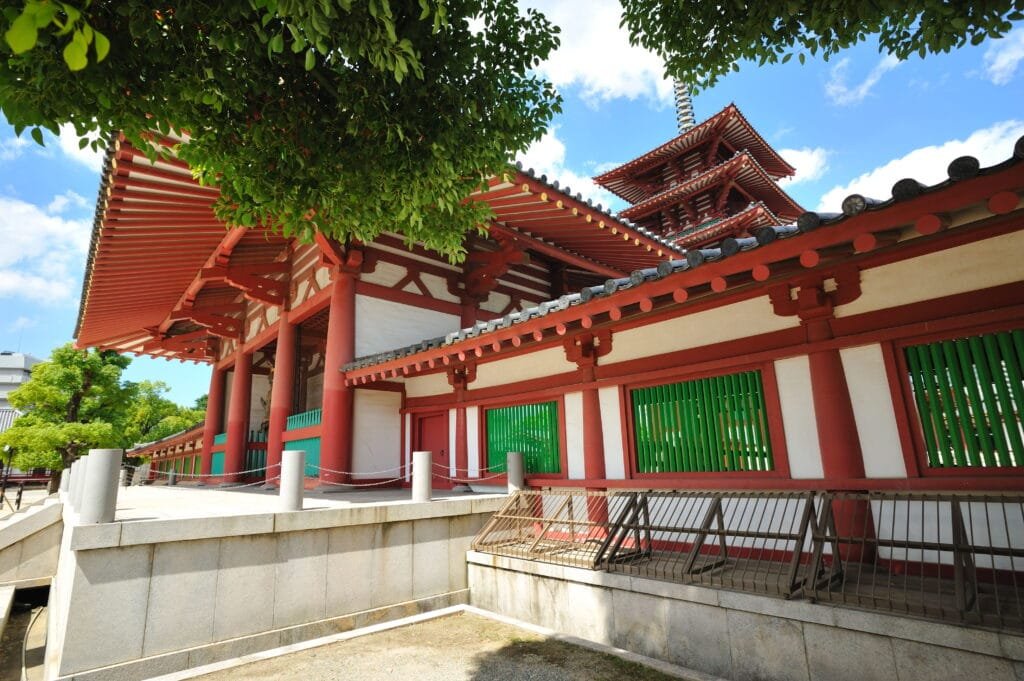
Watch a video on the Doya-Doya festival here
Final
Overall, the Doya-Doya festival is truly a unique festival that is unlike other. The sight of 600 odd people in nothing but a headband and underwear is quite bizzare but just adds to the historic and unique city of Osaka!




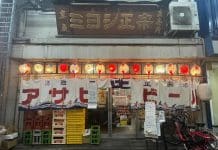



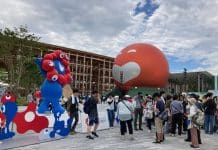











I’m glad you liked my photos.
I’m jcruz2000.
Nice article!
Was thinking of going this year, but again it’s been cancelled.
Warmest regard,
Jose Cruz
Thank you, Jose. Apologies if you don’t want the photos being used. Our writer, Andy, should have asked you first. Please email webmaster@osaka.com if you like the photos removed. With the lockdown finished, it must be good to visit the festival again 🙂
No, problem. I’m looking forward to the festivals, now I hope my work schedule allows for that. Great website!